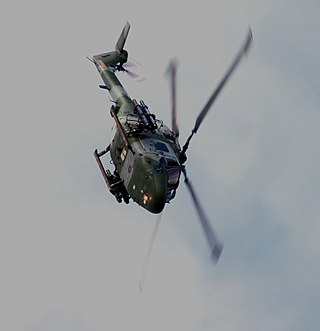Westland Helicopters was a British aircraft manufacturer. Originally Westland Aircraft, the company focused on helicopters after the Second World War. It was amalgamated with several other British firms in 1960 and 1961.

The Aérospatiale Gazelle is a five-seat helicopter developed and initially produced by the French aircraft company Sud Aviation, and later by Aérospatiale. It is the first helicopter to feature a fenestron tail instead of a conventional tail rotor, as well as being the first helicopter to be adapted for single-pilot operations under instrument flight rules.

The Army Air Corps (AAC) is the aviation arm of the British Army, first formed in 1942 during the Second World War by grouping the various airborne units of the British Army. Today, there are eight regiments of the AAC, as well as two independent flights and two independent squadrons deployed in support of British Army operations around the world. Regiments and flights are located in the United Kingdom, Kenya, and Canada. Some AAC squadrons provide the air assault elements of 16 Air Assault Brigade, through Joint Helicopter Command.

The Blue Eagles were the helicopter aerobatic team of the British Army Air Corps. It was one of only eight professional helicopter teams in the world, along with the Royal Navy Black Cats, Sarang of the Indian Air Force, the Scorpion aerobatic team of the Polish Air Force, Rotores de Portugal, the Patrulla Aspa of the Spanish Air Force, the Grasshoppers of the RNLAF and the US Army Silver Eagles. They were formed in the spring of 1968 by Air Corps instructors, and were established in the following years with five helicopters. In 2001, the team included the first British female military display pilot. In 2010, it was disbanded due to an ageing Westland Lynx fleet and financial cutbacks.

The Helicopter Museum in Weston-super-Mare, North Somerset, England, is a museum featuring a collection of more than 80 helicopters and autogyros from around the world, both civilian and military. It is based at the southeastern corner of the former Weston-super-Mare Airport and is the largest collection of helicopters in the world.
The North East Land, Sea and Air Museums (NELSAM), formerly the North East Aircraft Museum, is a volunteer-run aviation museum situated on the site of the former RAF Usworth/Sunderland Airport, between Washington and Sunderland, in Tyne and Wear, England. The museum has the largest aviation collection between Yorkshire and Scotland and houses over 30 aircraft and a wide collection of aero engines. The museum also has a small collection of other items such as weaponry, vehicles and other historical exhibits.
No. 663 Squadron was an air observation post (AOP) unit, manned with Polish Army personnel, which was officially formed in Italy on 14 August 1944. Numbers 651 to 663 Squadrons were air observation post units working closely with Army units in artillery spotting and liaison. A further three of these squadrons, 664–666, were manned with Canadian personnel. Their duties and squadron numbers were transferred to the Army with the formation of the Army Air Corps on 1 September 1957.
No. 671 Squadron AAC is squadron of the British Army's Army Air Corps. It was previously No. 671 Squadron RAF, a glider squadron of the Royal Air Force active during the Second World War as part of No. 229 Group RAF, South East Asia Command.
The South Yorkshire Aircraft Museum (SYAM) is a Volunteer led museum located at Lakeside in Doncaster, South Yorkshire, England. It occupies the former site of the Royal Air Force Station, RAF Doncaster. The museum occupies the last remaining original buildings from RAF Doncaster in the shape of a Bellman hangar, two wooden Air Ministry 'Billet Huts' (Buildings 19 and 21) and various smaller structures. The museum has also erected an more modern ex Air Training Corps Cadet Hut alongside Building 21 to house its World War Two Collection.

The Pakistan Army Corps of Aviation is a military administrative and combined arms service branch of the Pakistan Army.
6 Regiment Army Air Corps is the sole Army Reserve regiment of the British Army Air Corps (AAC) falling under the Combat Arm of the British Army. The regiment consists of five Squadrons based around the south of the UK. 6 Regiment provides soldiers trained to assist Joint Helicopter Command on exercise and operations both in the UK and worldwide. The regiment provides support to support and attack helicopter in roles including Aviation Ground crew specialists, Aviation Communication Operators and Aviation Support Officers. The AAC regiment is supported by other Army Reserve elements including Royal Logistic Corps as chefs, Logistics and Supply, Adjutant General Corps as human resource specialists and Royal Army Medical Corps in the form of Combat Medical Technicians.
Hobart Barracks is a former military airfield, located 1.6 km east-northeast of Detmold in North Rhine-Westphalia, Germany.
No. 654 Squadron AAC is a squadron of the British Army's Army Air Corps (AAC).
The Historic Army Aircraft Flight (HAAF) is a charitable trust which brings the history of British Army flying to life by preserving and flying a unique collection of historic British Army aircraft formerly operated by the Army Air Corps (AAC). It serves as a 'living museum' for ex-service personnel commemorative and memorial purposes, as an aid to recruiting, and for supporting wider British Army heritage in public. It features an aerial display group; comprising a de Havilland Beaver, a Westland Scout, an Agusta-Bell Sioux, and an Auster AOP.9.
No. 669 Squadron AAC is a squadron of the British Army's Army Air Corps (AAC) which was disbanded as a flying Squadron on 31 July 2016 and reformed as HQ Sqn 3AAC in 2021. It was formerly No. 669 Squadron RAF, a glider squadron of the Royal Air Force active during the Second World War as part of No. 229 Group RAF, South East Asia Command
No. 672 Squadron AAC is a former squadron of the British Army's Army Air Corps (AAC).








